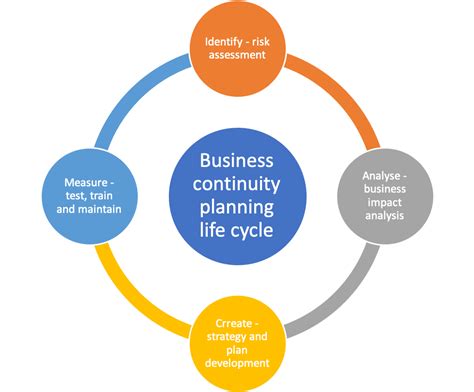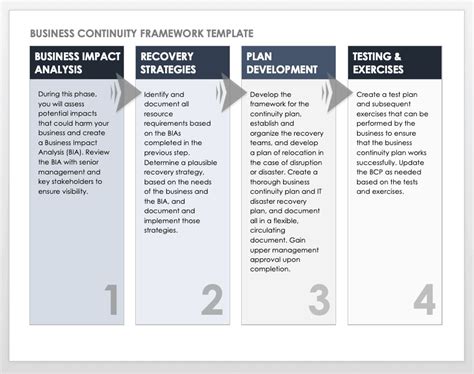Business continuity is a crucial aspect of IT operations, ensuring that an organization's critical systems and processes remain available and functional, even in the face of disruptions or disasters. With the increasing reliance on technology and the potential for unforeseen events, such as natural disasters, cyberattacks, or equipment failures, having a robust business continuity plan in place is essential for minimizing downtime and maintaining operational resilience. In this article, we will explore five key IT business continuity tips, designed to help organizations prepare for and respond to potential disruptions, ensuring the continuity of their IT services and maintaining business operations.
Key Points
- Conduct a thorough risk assessment to identify potential vulnerabilities and threats to IT operations
- Develop a comprehensive business continuity plan that outlines procedures for disaster recovery and IT service continuity
- Implement a robust backup and disaster recovery strategy to ensure data availability and system recoverability
- Establish a crisis management team to coordinate response efforts and maintain communication with stakeholders
- Regularly test and update the business continuity plan to ensure its effectiveness and relevance in the face of evolving threats and technologies
Tip 1: Conduct a Thorough Risk Assessment

A thorough risk assessment is the foundation of any effective business continuity plan. This involves identifying potential risks and threats to IT operations, assessing their likelihood and potential impact, and prioritizing them based on their severity. Risk assessments should consider a wide range of factors, including natural disasters, cyberattacks, equipment failures, and human error. By understanding the potential risks and vulnerabilities, organizations can develop targeted strategies to mitigate or manage them, reducing the likelihood of disruptions and ensuring business continuity.
Identifying Critical IT Systems and Processes
As part of the risk assessment, it is essential to identify critical IT systems and processes that are essential to business operations. This includes systems that support core business functions, such as customer service, sales, and finance, as well as infrastructure components, such as networks, servers, and data storage. By understanding the dependencies and inter relationships between these systems, organizations can develop strategies to ensure their continuity and availability, even in the face of disruptions.
Tip 2: Develop a Comprehensive Business Continuity Plan

A comprehensive business continuity plan is essential for ensuring the continuity of IT services and maintaining business operations. This plan should outline procedures for disaster recovery, IT service continuity, and crisis management, as well as provide guidance on communication, training, and testing. The plan should be developed in consultation with stakeholders, including IT staff, business leaders, and external partners, to ensure that it is comprehensive and effective. Business continuity plans should be regularly reviewed and updated to ensure their relevance and effectiveness in the face of evolving threats and technologies.
| Business Continuity Plan Component | Description |
|---|---|
| Risk Assessment | Identification and assessment of potential risks and threats to IT operations |
| Business Impact Analysis | Assessment of the potential impact of disruptions on business operations and IT services |
| Disaster Recovery Plan | Procedures for recovering IT systems and data in the event of a disaster |
| Crisis Management Plan | Procedures for managing and responding to crises, including communication and stakeholder management |

Establishing a Crisis Management Team
A crisis management team is essential for coordinating response efforts and maintaining communication with stakeholders in the event of a disruption. This team should include representatives from IT, business leadership, and external partners, and should be responsible for implementing the business continuity plan and managing the response to disruptions. The team should be trained and equipped to respond to a wide range of scenarios, and should have clear lines of communication and decision-making authority.
Tip 3: Implement a Robust Backup and Disaster Recovery Strategy
A robust backup and disaster recovery strategy is essential for ensuring the availability and recoverability of IT systems and data. This should include regular backups of critical data, as well as procedures for recovering systems and data in the event of a disaster. Backup and disaster recovery strategies should be designed to meet the specific needs of the organization, taking into account factors such as data volume, system complexity, and recovery time objectives. By implementing a robust backup and disaster recovery strategy, organizations can minimize downtime and ensure the continuity of IT services.
Cloud-Based Backup and Disaster Recovery
Cloud-based backup and disaster recovery solutions offer a cost-effective and scalable alternative to traditional on-premises solutions. These solutions provide secure and reliable storage for critical data, as well as automated backup and recovery procedures, reducing the risk of data loss and minimizing downtime. Cloud-based solutions also offer greater flexibility and scalability, allowing organizations to quickly respond to changing business needs and evolving threats.
Tip 4: Establish a Training and Testing Program
Establishing a training and testing program is essential for ensuring the effectiveness of the business continuity plan and the preparedness of IT staff and stakeholders. This program should include regular training sessions, tabletop exercises, and live drills, designed to test the plan and identify areas for improvement. Training and testing programs should be tailored to the specific needs of the organization, taking into account factors such as staff expertise, system complexity, and recovery time objectives. By establishing a training and testing program, organizations can ensure that their business continuity plan is effective and relevant, and that IT staff and stakeholders are prepared to respond to disruptions.
Continuous Monitoring and Review
Continuous monitoring and review are essential for ensuring the ongoing effectiveness and relevance of the business continuity plan. This should include regular reviews of the plan, as well as monitoring of IT systems and processes, to identify areas for improvement and ensure that the plan remains aligned with evolving business needs and threats. By continuously monitoring and reviewing the plan, organizations can ensure that their business continuity plan remains effective and relevant, and that IT services are available and reliable.
Tip 5: Regularly Review and Update the Business Continuity Plan

Regularly reviewing and updating the business continuity plan is essential for ensuring its ongoing effectiveness and relevance. This should include regular reviews of the plan, as well as updates to reflect changes in business needs, technologies, and threats. Plan updates should be based on lessons learned from training and testing, as well as feedback from stakeholders, to ensure that the plan remains comprehensive and effective. By regularly reviewing and updating the business continuity plan, organizations can ensure that their IT services are available and reliable, and that business operations are maintained, even in the face of disruptions.
What is the primary goal of a business continuity plan?
+The primary goal of a business continuity plan is to ensure the continuity of IT services and maintain business operations, even in the face of disruptions or disasters.
How often should a business continuity plan be reviewed and updated?
+A business continuity plan should be reviewed and updated regularly, ideally every 6-12 months, to ensure its ongoing effectiveness and relevance.
What is the role of a crisis management team in business continuity planning?
+The crisis management team is responsible for coordinating response efforts and maintaining communication with stakeholders in the event of a disruption, and for implementing the business continuity plan.
Meta Description: Discover 5 essential IT business continuity tips to ensure the continuity of your IT services and maintain business operations, even in the face of disruptions or disasters. Learn how to develop a comprehensive business continuity plan, implement a robust backup and disaster recovery strategy, and establish a crisis management team.



